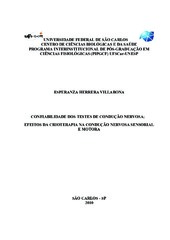Confiabilidade dos testes de condução nervosa: efeitos da crioterapia na condução nervosa sensorial e motora

Visualizar/
Data
2010-09-03Autor
Villabona, Esperanza Herrera
Metadata
Mostrar registro completoResumo
This thesis presents three manuscripts derived of two research projects that were developed during the doctorate program. Project 1. Purpose: To determine the interand intra-rater reliability of nerve conduction studies (NCS) of superficial peroneal, sural and medial plantar nerves. Methods: Two raters performed the bilateral NCS twice in 20 healthy participants (23.5±3.5 years). Reliability was analyzed by the Bland- Altman method and intraclass correlation coefficient (ICC). Results: The Bland-Altman method showed a good level of intra- and inter-rater agreement for all parameters nerves. The amplitude and latency of the medial plantar nerve (rater 1), as well the amplitude of the sural nerve (rater 2) had an intra-rater ICC ≥0.75. Inter-rater analysis showed concordance levels between moderate and very low. Project 2. Purposes: a) To compare the effects of three cold modalities on the nerve conduction parameters of the sural (sensory) and tibial (motor) nerves during cooling and post-cooling phases b) To analyze the effect of exercise on recovery of sensory and motor nerve conduction velocity (NCV). Methods: Thirty six healthy young subjects (20.5±1.9 years) were randomly allocated into three groups: ice massage (n=12), ice pack (n=12) and cold water immersion (n=12). Each group received 1 of the 3 cold modalities on the right calf region for 15 minutes. The subjects of each modality group were again randomized to perform a post-cooling activity (30 min rest or walk 15 min followed by rest 15min). Nerve conduction parameters of sural and posterior tibial nerves were evaluated. Results: All 3 modalities reduced amplitude and increased latency and duration of the compound action potential. Ice massage, ice pack, and cold water immersion reduced NCV by 20.4, 16.7, and 22.6 m/s and motor NCV by 2.5, 2.1, and 8.3 m/s, respectively. Cold water immersion, as applied in this study, was the most effective modality in changing nerve conduction parameters. The walk accelerated the recovery of sensory and motor NCV, regardless of the modality previously applied (p<0.0001). Conclusions: The NCS provides quantitative measures that contribute to the objective analysis of neural physiological effects of cryotherapy. All 3 modalities were effective in altering sensory and motor nerve conduction. However, the magnitude and duration of these effects depend on the method applied and the activity after cooling.